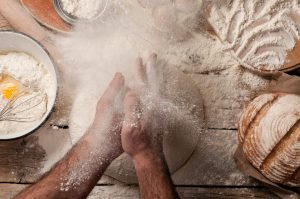
Photo credit: iStock.com/KucherAV
“Baker’s asthma” — as it’s known in the business — is a serious health problem that can affect workers in bakery, flour manufacturing, and food processing settings.
“Activities such as mixing, pouring, and weighing flour creates airborne flour dust, which workers may inhale,” reads Flour dust exposure, a risk advisory from WorkSafeBC.
“Workers exposed to flour dust may develop an allergy or sensitization after repeated exposures. Once sensitization occurs, exposure to even a small amount of flour dust can trigger an asthma attack or allergic reaction.”
Safety training in baking school
Martin Barnett is an instructor and program chair of the professional Baking and Pastry Arts program at Vancouver Island University. He’s also on the Board of Directors of the Baking Association of Canada.
I asked him if the issue of flour dust is covered in schools. Is it on the safety radar of the baking industry?
Martin says the issue of flour dust is “not on the official curriculum, as a stand-alone subject, but we do teach it in ‘safe working practices.’ ”
Martin knows first-hand what it’s like to work around flour dust. He says: “I myself am sensitive, and when I owned my bakery in Victoria I wore a mask. Now I use an inhalant on days that I know I am going to be mixing a lot.”
Of course, different prevention tactics will be called for, depending on the situation. Martin says most modern bakeries use extractor fans and workers are mandated — that is, “strongly encouraged” — to wear filtering facepiece respirators. Delivering flour by silo and using machines’ speed controls correctly can also help mitigate the risk.
WorkSafeBC’s Geoffrey Clark, senior occupational hygienist, says that many controls in the exposure control plan for flour dust are procedural or “administrative” and involve modifying work practices, rather than wearing respirators. He says: “Research has found that changing how bakers work can significantly reduce their exposures to flour dust.”
For much more information, see Exposure Control Plan for Flour Dust in Bakeries and Sample Respirator Program for Flour Dust Exposure, both published recently by WorkSafeBC. You can also learn more about flour dust on worksafebc.com.
Thanks to Martin for answering my questions about his work.


